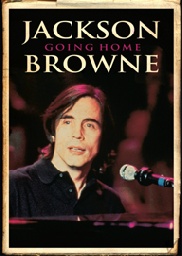Home » Jazz Articles » Film Review » Jackson Browne: Going Home
Jackson Browne: Going Home
 Jackson Browne
Jackson BrowneGoing Home
Eagle Vision
2010
Jackson Browne remains the most compelling of the singer/songwriters from the 1970s because his more recent work, such as I'm Alive (Elektra, 1993)—in the wake of which this documentary was produced—resonates as profoundly as his earliest releases, such as Late For The Sky (Asylum, 1974). Originally produced for The Disney Channel, Going Home dazzles with its creative mix of live performance footage, conceptual videos and interview segments from various junctures in the man's career. The DVD displays the same continuity as Browne's own body of work.
In contrast to the somewhat dour image portrayed in photographs, Browne displays real gusto when playing music live. "Doctor My Eyes" has never sounded more like a romp than it does early on in these 90 minutes, which only stands to reason considering the versatile band Browne has gathered around him; at the time of this documentary, the lineup including multi- instrumentalist and vocalist Scott Thurston (now a mainstay of Tom Petty's Heartbreakers). Then, of course, there is Browne's long-standing bond with instrumental wizard David Lindley, who's pictured repeatedly on lap steel and fiddle (among his other exotic instruments), adding, at one point, a cathartic bittersweet quality to "These Days."
It's also to be expected that interviews with Jackson Browne himself would be the most revelatory of the many included here (numbering The Eagles' Don Henley and Lindley, as well as Graham Nash and David Crosby). Still, those recurring segments, recorded in a warehouse where Browne had been storing his personal affects, are unusually insightful. He is continually surprised at what he discovers in his written notes and among his possessions.
Clarity of sound and video in the main concert sections is indicative of the superior production values Browne's recordings have always offered and that high level of quality carries over into the sequencing of the DVD as a whole. Abrupt jumps occur occasionally, as when Lindley discusses his fondness for polyester clothing with a bemused Browne; but in general, the cumulative momentum remains, so much so that the pacing actually heightens interest as the film progresses.
Less high-quality video and audio content is expertly edited to become interwoven with the latter-day performances, as on "Take It Easy," and thus becomes a metaphor for the relentless passage of time that has remained an ongoing theme in Browne's compositions. It's also indicative of the radiant strength of his aesthetic, about which he remains visibly proud.
There are some advantages and disadvantages in that respect when considering the political and social concerns he's championed during his time in the limelight. Songs such as "Lives in the Balance" offer nowhere near the penetrating insights into the human condition as the likes of "The Pretender," though that says perhaps more about the limits of topical song than Browne's mastery of his craft.
It's thus illuminating to hear Graham Nash speak of the solidifying influence Jackson Browne brings to the causes they champion together, such as the MUSE initiative. Jackson Browne's devotion to benefits he supports may be, in fact, more effective than the songs he's composed specifically to address such causes; as palpable as the stoic acceptance is within "For Everyman," it is in stark contrast to the author's vigorous activism.
There are no bonus features included on Going Home, but then there don't need to be. The DVD as a whole is a stunning combination of material and it works flawlessly to render a portrait of a man who, contrary to the emotive reading behind the end credits, is most definitely not "running on empty..."
Production Notes: 90 minutes. Extras: Special appearances: David Lindley; David Crosby; Graham Nash; Jennifer Warnes.
< Previous
Piano Tracks, Volume 1
Next >
The Master And The Rain
Comments
Tags
For the Love of Jazz
 All About Jazz has been a pillar of jazz since 1995, championing it as an art form and, more importantly, supporting the musicians who create it. Our enduring commitment has made "AAJ" one of the most culturally important websites of its kind, read by hundreds of thousands of fans, musicians and industry figures every month.
All About Jazz has been a pillar of jazz since 1995, championing it as an art form and, more importantly, supporting the musicians who create it. Our enduring commitment has made "AAJ" one of the most culturally important websites of its kind, read by hundreds of thousands of fans, musicians and industry figures every month.






















